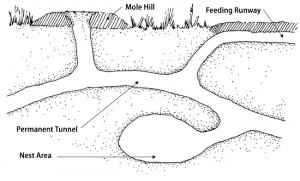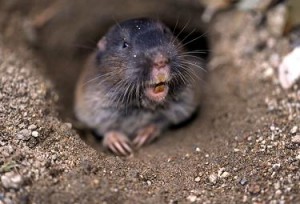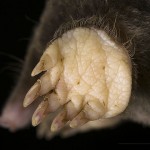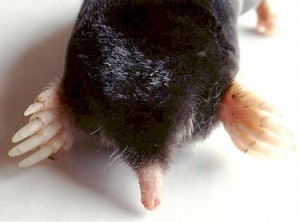MN Wild Animal Management | Mole Removal
Still not sure if you have moles in your yard?
Common characteristics of mole yard damage are torn-up flowerbeds and torn-up grass roots from inconvenient burrowing habits leaving your yard a mess! It is important, however, to properly identify the source of this yard damage before setting out to trap the moles you think you have in your yard.
Signs of Moles
Moles are active all year round at any time of day, but are rarely seen due to their underground existence. They are best recognized by their molehills, which they push up along their tunnel systems. Both moles and pocket gophers construct tunnels and mounds, but there are distinct differences.
Before setting out to control what you assume to be mole damage, be sure to properly identify the animal causing the damage.
| Differences between moles and pocket gophers. | |
| Moles | Pocket Gophers |
| Minute eyes are often not visible. | Small eyes are clearly visible. |
| Muzzle is long and tapering. | Muzzle is rounded. |
| The many small teeth are not apparent. | Orange, chisel-like pairs of upper and lower incisors are apparent. |
| Mounds are round when viewed from above. | Mounds are crescent- or heart-shaped when viewed from above. |
| Soil plug is in the middle of mound and may not be distinct. | Soil plug is in the middle of the V shape or off to the side of the mound and may leave a visible depression. |
| Tunnels are often just beneath the surface, leaving a raised ridge. | No tunnels are visible from above ground. |

Figure 4. Cross-section of a mole’s runway system. A single mole can construct 200 mounds over the course of a winter.
A mole’s territory is a mazelike system of connecting, intertwining underground tunnels located at various depths (Fig. 4). It’s a perfect fortress in which to survive threats, either natural or man made—drought, freezes, predators, toxic gases, and other poisons. They routinely scent-mark their tunnels while patrolling for insects and other invertebrates that travel or fall into their tunnel systems.
Moles construct two kinds of tunnels: surface tunnels and deep tunnels, or runways. Surface tunnels are located 1 to 4 inches below the surface. These appear as 3-inch wide ridges or rips in the lawn or in soil, or as puffed-up areas in mulch. In lawns, surface tunnels are often held together only by the surrounding grass roots, and you may see the ridges—or feel them as you step on them. Surface tunnels wind around with no apparent direction or plan; they are used once or revisited several times for feeding purposes, and possibly for locating mates in the breeding season.
Surface tunnels connect with deeper runways that are located 3 to 12 inches below the surface, but may be as deep as 40 inches. Deep runways are main passageways that are used daily as the mole travels to and from surface tunnels and its nest.
Moles are fast diggers and can tunnel at a rate of 15 feet per hour. In favorable areas, shallow tunnels can be built at a rate of 12 inches per minute.
Digging is most pronounced in fall and winter when the soil is moist and easy for moles to work. In periods of dry weather or drought, moles tunnel deeper, near moist, cool areas where insects and worms congregate—along sewer drainfields and under sidewalks, rocky area, and shady fence rows.
Mole Damage

Pocket Gopher – Pocket gophers are stout-bodied rodents with small ears and eyes and large clawed front paws. Their large front teeth are used to loosen soil and rocks while digging, as well as to cut and eat roots.
Because of the surface tunnels and mounds they create, moles may be considered pests in yards, ball fields, golf courses, and other locations. Moles may also inadvertently heave small plants out of the ground as they tunnel, or damage plants when their mounds cover small seedlings.
Moles, gophers, and voles (large mouse-like rodents which also occupy mole tunnels) can be found in the same location, and positive identification is needed, as control methods differ for each species.
Moles are here to stay and extermination is very difficult, and even harder to discourage from coming back, especially if your property borders an area that has typically served as a source of moles. The activity in certain lawns can simply come and go throughout the season. On large properties the activity may gypsy from one part of the lawn to another. This movement or migrating is controlled by climate and ground moisture. Moles will adapt to changes in food supply and source as different insects become available in different places and at different times throughout the year.
While you may be able to remove an existing mole population or drive moles elsewhere, if suitable conditions exist and moles occur nearby, other moles will eventually move into vacated areas. In addition, it is important to understand that mole problems rarely can be resolved by a quick fix method, but that a continuing commitment to whatever solutions are adopted is required.
Mole Removal
Moles are the bane of many Minnesota home owners at this time of year. Nothing can ruin your expensive landscaping, vegetable garden, or your prized destroy floral beds faster than moles. The sooner you get rid of these pests, the sooner you’ll be able to reclaim your backyard.
If you have a nuisance mole control problem, the best solution to remove the moles from your property is through mole trapping. If moles are causing property damage, calling a Minnesota Wild Animal Management Expert ensures humane and effective removal of this most annoying animal and to be sure they will not return.
Through effective and efficient mole control techniques, you CAN eliminate your mole problems using humane animal handling techniques and mole control strategies.






